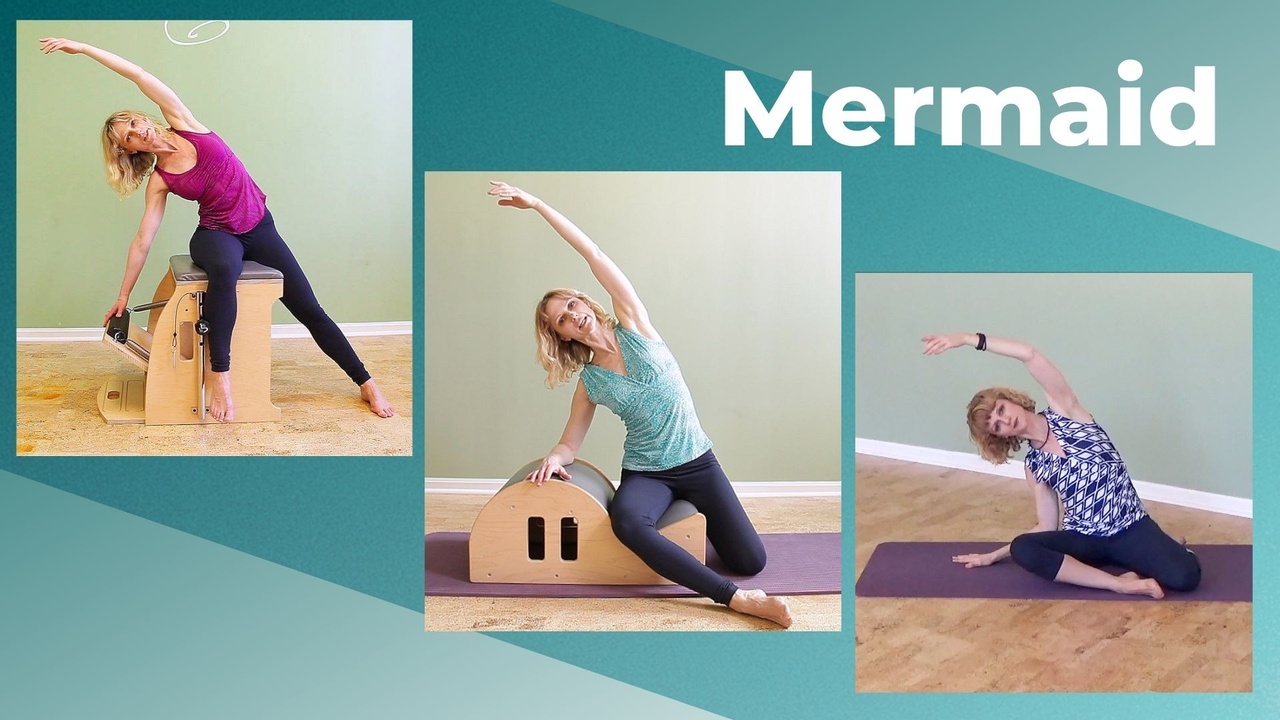Mermaid - The Most Important Spine Mobility Exercise in Pilates
Jul 21, 2021
The Mermaid is, without a doubt, the most important spine mobility exercise in the Pilates repertoire. Thankfully, there are variations of Mermaid on every single piece of apparatus (and sometimes two).
Mermaid On The Mat
As so often with Pilates exercises, the mat variation is the most difficult of all Mermaids, but - because everyone can do it at home - it's the one almost everyone knows and practices.
Sitting in the Z-Sit position can be quite challenging if you or your student lack hip mobility, especially internal hip rotation. In that case, sitting on a blanket, cushion, or wedge can help.
Usually, the Mermaid begins with lateral flexion of the spine and then adds rotation. On the mat, rotation is combined with flexion and extension, so basically you're moving your spine through all possible movement directions.
I (half-)jokingly used to tell my students "A Mermaid a day keeps the doctor away."
As I'm sure you know, a Pilates teacher has to get up and down to the floor a lot when teaching Pilates mat classes. Over time, I learned to improve my verbal cueing to the point that I didn't have to lie or sit down for each exercise. But I made an intentional exception with the Mermaid. I often practiced Mermaid three to four times a day, if I taught that many mat classes that day. What a treat!
Let's take a look.
Mermaid On The Trapeze Table
The Mermaid on the Pilates Cadillac (or Tower) doesn't require hip mobility, very little shoulder stability and you don't have to get down to the floor. But it is the most challenging variation in terms of spine rotation and rotation combined with flexion and extension. While these combinations can be contraindicated for students with spine conditions, for healthy students who would like to improve their spine mobility, they are gold! The push-through bar provides great leverage to deepen the rotation of your spine. Watch out! This'll be fun! 😉 You know the weird "torture-like" kind of fun we Pilates-geeks fall for.
Mermaid on The Spine Corrector
Sitting in the Spine Corrector makes the Mermaid much easier for those clients with tight hips. The seat of the Spine Corrector elevates your hips off the floor which reduces the required range of motion in your hips to sit comfortably.
On top of that, I love the isometric stretch into rotation. It feels so yummy.
Mermaid Sitting On The Chair
This seated variation of Mermaid on the Chair is my go-to Mermaid for older clients or anyone who has trouble getting down to the floor (and back up).
I tell my students to keep the foot of the straight leg glued to the floor (and not let it slide). This way I don't have to worry that anyone tumbles over the pedal side of the chair (if they weren't prepared for a light spring, for example), and they get an amazing stretch along the whole side body thanks to the training principle of opposition.
Adding spine rotation to this simple exercise will help many people relieve back tension quickly.
Mermaid Kneeling Next To The Chair
This is the only variation of Mermaid where you're not sitting. This makes it one of the more difficult versions. You'll have to control your upright posture from your knees to the top of your head.
It also required a fair amount of shoulder stability and shoulder girdle organization. So, I would not recommend it for a beginner or for anyone with anterior pelvic tilt. A typical common mistake is to fold at the hips (sit back) when pressing the pedal down. This can be corrected by remembering to elongate the spine. Stay tall as you reach.
We tend to shrink (compress the spine) as we laterally flex the spine, so I like to tell my students "Up is more important than over." in all of the Mermaids (or any side bend for that matter), meaning focus more on spinal length than lateral flexion.
Another common mistake in all of the Mermaids is the top arm. For most people, it is too far back. Your upper arm is supposed to be in your peripheral vision, not next to or behind your ear. Look at your students the next time you teach Mermaid, and you'll know what I mean. By encouraging them to move the lifted arm just a few inches forward, the tension in the muscles around their neck will "magically" disappear.
Now that you know these exercises, learn how to teach them better. Learn all the common mistakes and the best cues to correct them.
Get instant access to the Pilates Encyclopedia library.
I'd love to hear from you: Which Mermaid is your favorite variation and why? Shoot me an email.










